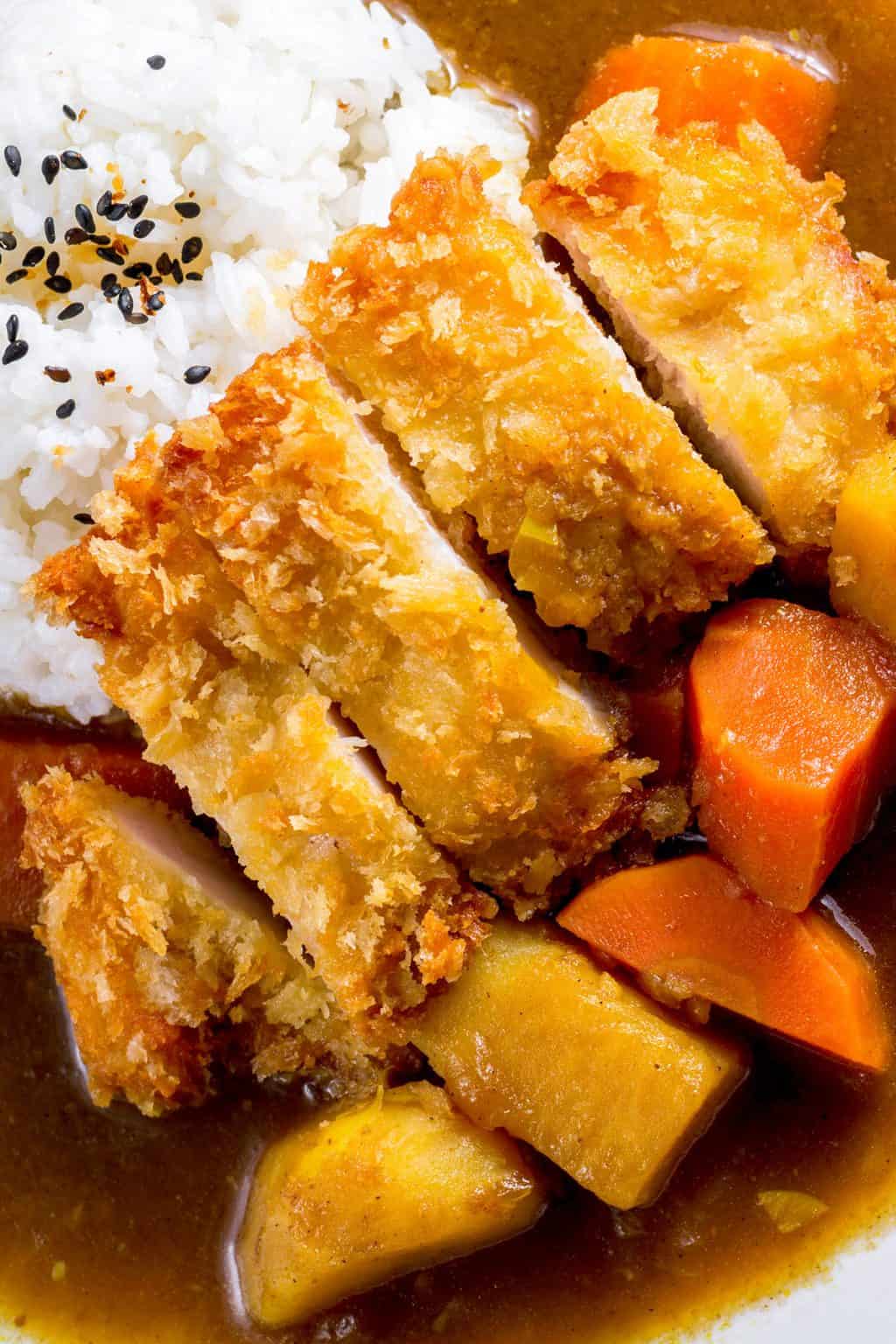A Deep Dive into the World of Katsu Curry: From Humble Beginnings to Culinary Masterpiece
Related Articles
- A Journey Through The Flavors Of Gudeg Jogja: A Culinary Adventure
- A Pocketful Of Flavor: A Deep Dive Into The World Of Empanadas
- Gazpacho: A Culinary Journey Through Spain
- Trendy Algae Recipes: Incorporating Spirulina And Seaweed Into Everyday Meals
- A Culinary Journey Through North Africa: Tagines, Couscous, And Chermoula Sauces
Introduction
Join us as we explore A Deep Dive into the World of Katsu Curry: From Humble Beginnings to Culinary Masterpiece, packed with exciting updates
A Deep Dive into the World of Katsu Curry: From Humble Beginnings to Culinary Masterpiece

Katsu curry, a beloved dish in Japan, is a symphony of flavors and textures that marries the satisfying crunch of breaded, deep-fried cutlets with the rich, aromatic complexity of curry sauce. Its journey from a simple, utilitarian dish to a culinary icon is a fascinating tale of culinary innovation and cultural exchange.
From the Streets of Japan to Your Kitchen: A History of Katsu Curry
The story of katsu curry starts with two distinct culinary traditions: the Japanese "katsu" and the Indian "curry."
Katsu: A Crispy Legacy
"Katsu" translates to "cutlet" in Japanese, and it refers to a dish of thinly sliced meat, often pork or chicken, that’s breaded and deep-fried until golden brown and crispy. This technique, popularized in Japan in the 19th century, was inspired by Western cutlets, particularly the "tonkatsu" (pork cutlet) that was introduced by Western chefs. The Japanese, however, put their own spin on the dish, developing a unique breading technique using panko breadcrumbs, which contribute to the characteristic light and airy texture of katsu.
Curry: A Journey Across Continents
Curry, on the other hand, has a long and complex history that spans centuries and continents. Its origins can be traced back to the Indian subcontinent, where a variety of spice blends and cooking techniques were used to create flavorful stews and curries. Curry reached Japan in the late 19th century, brought by British sailors and traders. Initially, it was served as a Western dish in hotels and restaurants, but it quickly captured the Japanese palate and evolved into a unique, distinctly Japanese style of curry.
The Fusion: Katsu Curry’s Birth
The fusion of "katsu" and "curry" into the beloved dish we know today is attributed to a combination of factors. The early 20th century saw a rise in inexpensive "curry rice" shops in Japan, offering affordable meals for the working class. These shops began serving katsu alongside their curry, creating a perfect marriage of crispy, savory cutlet and rich, flavorful sauce. This combination proved to be a resounding success, quickly gaining popularity among the Japanese population.
The Art of Katsu Curry: Deconstructing the Dish

Katsu curry, at its core, is a simple dish with a few key components:
- Katsu: The crispy, breaded cutlet, typically made with pork or chicken, but also available in vegetarian versions using tofu or vegetables.
- Curry Sauce: A rich, flavorful sauce that is the heart of the dish. It is usually a blend of spices, vegetables, and meat or vegetable stock, and can range from mild to spicy depending on the desired flavor profile.
- Rice: A fluffy bed of Japanese rice, often cooked with a bit of butter or oil for a richer flavor.
- Garnishes: A variety of toppings like pickled ginger, fukujinzuke (pickled vegetables), and Japanese curry powder can be added for a burst of flavor and color.
Mastering the Katsu: Techniques for Crispy Perfection
The katsu is the star of the show, and its success hinges on achieving the perfect crispy texture. Here’s a breakdown of the key techniques:
1. Choosing the Right Meat:
- Pork Loin: A classic choice for its tender texture and rich flavor. Look for a cut with a good amount of marbling for juiciness.
- Chicken Breast: A lean and flavorful option, especially when pounded thin for quicker cooking.
- Other Options: Beef, tofu, or even vegetables can be used for a vegetarian katsu.

2. Tenderizing and Shaping:
- Pounding: Tenderizing the meat with a meat mallet helps to ensure even cooking and creates a more delicate texture.
- Shaping: The meat can be shaped into a single large cutlet or multiple smaller ones, depending on preference.
3. The Art of Breading:
- Flour: A light dusting of flour helps the egg adhere to the meat.
- Egg Wash: A beaten egg creates a binding agent for the breadcrumbs.
- Panko Breadcrumbs: These Japanese breadcrumbs are essential for the signature light and airy texture of katsu.
4. Deep-Frying to Perfection:
- High Heat: Deep-frying at a high temperature (around 350°F) ensures a crispy exterior while maintaining a juicy interior.
- Proper Oil: Use a neutral oil with a high smoke point like vegetable oil or canola oil.
- Don’t Overcrowd: Avoid overcrowding the pan to ensure even cooking and prevent the oil temperature from dropping too much.
- Draining: After frying, drain the katsu on paper towels to remove excess oil.
Curry Sauce: A Symphony of Flavors
The curry sauce is the soul of the dish, and it can be as simple or as complex as you like. Here’s a guide to crafting a delicious curry sauce:
1. The Base:
- Vegetables: Onions, carrots, and potatoes are staples in many curry sauces. Other vegetables like celery, garlic, ginger, and bell peppers can also be added for added flavor and depth.
- Stock: Chicken or vegetable stock forms the base of the sauce, providing richness and flavor.
2. Spices:
- Curry Powder: The foundation of the curry flavor, available in various blends with different heat levels.
- Other Spices: Individual spices like turmeric, cumin, coriander, garam masala, chili powder, and ginger can be added for further complexity.
3. The Finishing Touches:
- Tomato Paste: Adds a tangy sweetness and deepens the flavor.
- Soy Sauce: Adds umami and a savory note.
- Sugar or Honey: Balances the spiciness and adds a hint of sweetness.
4. Cooking Techniques:
- Sautéing: Sautéing the vegetables in oil before adding the other ingredients develops flavor and creates a rich sauce.
- Simmering: Simmering the sauce allows the flavors to meld and create a harmonious blend.
5. Texture and Consistency:
- Thickening Agent: A slurry of cornstarch or flour can be added to thicken the sauce to your desired consistency.
- Creamy Finish: A dollop of cream or milk can be stirred in for a smoother, richer texture.
Building a Katsu Curry Feast: Variations and Sides
Katsu curry is a versatile dish that can be adapted to suit your preferences and dietary needs. Here are some ideas for creating a diverse and satisfying meal:
1. Katsu Curry Variations:
- Spicy Katsu Curry: Add more chili powder or cayenne pepper to the curry sauce for a fiery kick.
- Vegetarian Katsu Curry: Substitute the meat with tofu or vegetables, like eggplant or mushrooms.
- Sweet Katsu Curry: Use less chili powder and more sugar or honey for a sweeter, milder flavor.
- Japanese Curry with Coconut Milk: Add a can of coconut milk to the curry sauce for a creamy, tropical twist.
- Katsu Curry with Japanese Pickles: Pair the dish with pickled ginger or fukujinzuke for a refreshing contrast.
2. Side Dishes:
- Salad: A simple salad with a light vinaigrette can help to cut through the richness of the curry.
- Pickled Vegetables: Japanese pickles like takuan (radish pickles) or umeboshi (pickled plums) offer a tangy and refreshing complement to the curry.
- Rice Dishes: Try serving the katsu curry with Japanese rice dishes like onigiri (rice balls) or oyakodon (chicken and egg rice bowl).
3. Drinks:
- Green Tea: A classic pairing for Japanese cuisine, green tea helps to cleanse the palate and refresh the taste buds.
- Japanese Beer: A refreshing and flavorful beer, like Sapporo or Asahi, can complement the savory flavors of the curry.
- Fruit Juice: A sweet and refreshing juice like apple juice or orange juice can help to balance the spiciness of the curry.
Culinary Tips for Mastering Katsu Curry
1. Planning Ahead:
- Marinating: Marinating the meat in soy sauce, ginger, and garlic before breading can enhance flavor and tenderness.
- Prepping the Vegetables: Chop all vegetables in advance for efficient cooking.
- Making the Curry Sauce: Prepare the curry sauce ahead of time and refrigerate it for up to three days.
2. Cooking Techniques:
- Don’t Overcrowd the Pan: Avoid overcrowding the pan when frying the katsu to prevent the oil temperature from dropping and ensuring even cooking.
- Use a Thermometer: Monitor the oil temperature with a deep-fry thermometer to ensure optimal frying conditions.
- Simmer, Don’t Boil: Simmer the curry sauce gently to allow the flavors to develop and prevent the sauce from becoming too thick.
3. Serving and Storage:
- Serve Immediately: Serve the katsu curry hot and fresh for the best flavor and texture.
- Storing Leftovers: Store leftover katsu curry in an airtight container in the refrigerator for up to three days.
- Reheating: Reheat the curry gently over low heat on the stovetop or in the microwave.
4. Experimentation:
- Spice Levels: Adjust the amount of chili powder or cayenne pepper to your preferred level of heat.
- Vegetable Variations: Experiment with different vegetables in the curry sauce to add variety and depth of flavor.
- Garnishings: Add a variety of garnishes like pickled ginger, fukujinzuke, or Japanese curry powder for a burst of flavor and color.
5. Enjoying the Journey:
- Embrace the Process: Katsu curry is a dish that rewards patience and attention to detail. Enjoy the process of preparing each component and savor the flavors of this culinary masterpiece.
- Share the Experience: Katsu curry is a dish that is meant to be shared with loved ones. Invite friends and family to experience the joy of this flavorful Japanese classic.
Conclusion: A Culinary Adventure Awaits
Katsu curry is more than just a dish; it’s a testament to the power of culinary fusion and the enduring appeal of simple yet satisfying flavors. From its humble beginnings as a street food staple to its current status as a beloved Japanese comfort food, katsu curry has captured hearts and stomachs around the world. By understanding the history, techniques, and variations of this culinary icon, you can embark on your own culinary adventure, creating delicious and personalized versions of this timeless classic. So gather your ingredients, sharpen your knives, and get ready to experience the magic of katsu curry.
Closure
We hope this article has helped you understand everything about A Deep Dive into the World of Katsu Curry: From Humble Beginnings to Culinary Masterpiece. Stay tuned for more updates!
Make sure to follow us for more exciting news and reviews.
We’d love to hear your thoughts about A Deep Dive into the World of Katsu Curry: From Humble Beginnings to Culinary Masterpiece—leave your comments below!
Stay informed with our next updates on A Deep Dive into the World of Katsu Curry: From Humble Beginnings to Culinary Masterpiece and other exciting topics.







